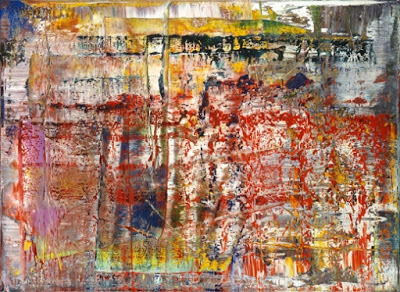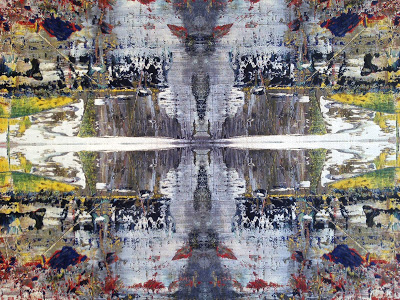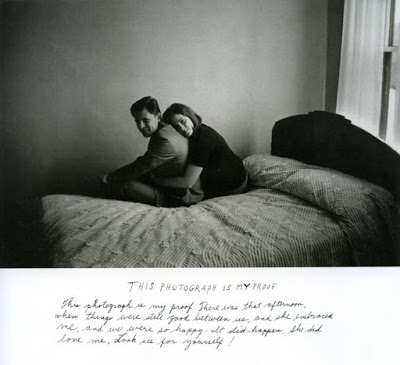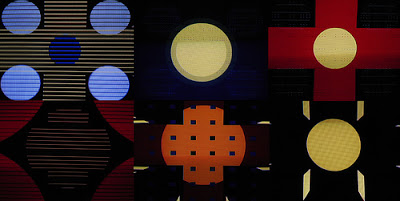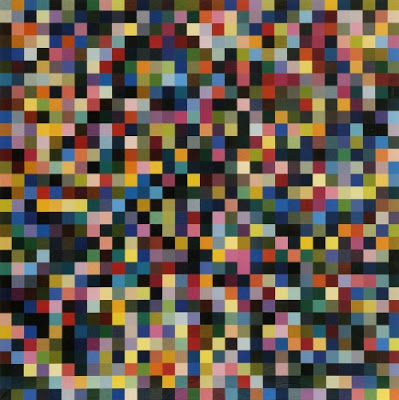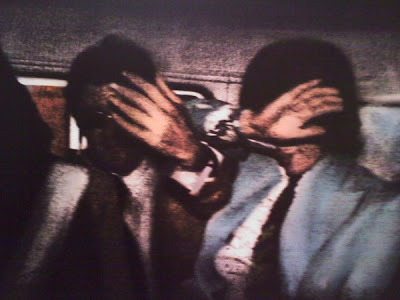Gerhard Richter
Art Vent Letting the Fresh Air In
July 13, 2013
For the first time in almost ever, I took a couple of months off from writing….anything. I was tired of having ideas, tired of the urgency to express them, wanted to concentrate on making art, not thinking about it. Well I found it didn’t pay—just like avoiding the gym doesn’t pay—because now what I’m left with is mental flab and a limp writing muscle. A paragraph that just a few months ago would take five minutes to write, now takes an entire morning—with myriad breaks for coffee and food. Therefore, like not exercising, not writing can be fattening—especially in England, where I am until tomorrow, and where everything goes better with double cream.
Also I hadn’t seen any art that knocked my socks off. The Paul McCarthy show at the Armory put me in such a bad mood, and even the Turrell installation at the Guggenheim, which I wanted to like in the worst way (more about that in another post), left me cold. I fled to Paris, anticipating “Dynamo,” an exhibition of sound and motion at the Grand Palais, but it was the white cheese and passion fruit dessert in the museum café that really turned me on. Sometimes I think I’ve chosen the wrong field.
However if anyone can pull me out of a torpor, it’s Gerhard Richter. Usually there’s a lot on in the London summer season, but this year the only thing I really wanted to see was the exhibition(up through July 27) at Gagosian on Davies Street of four Richter tapestries from 2009—which, as it turned out, could be his most magnificent work ever.
The tapestries are based on a single scraped painting: Abstract Painting (724-4) (1990). This is the same one he mined for his book, Patterns: Divided, Mirrored, Repeated(2012), from which he generated the the large-scale digital Strip Paintings, shown at Marian Goodmanlast season, which I reviewed for Art in America.
Gerhard Richer, Abstract Painting (724-4) (1990)
Woven on a mechanical jacquard loom, each tapestry represents a Rohrschach-like four-time multiplication of one quadrant of the original image. Dense and rich, they appear at once medieval and futuristic, tribal and Baroque, with varying texture, thick and thin, and colors that range from murky to brilliantly clear.
While my friend and I stood riveted for at least 20 minutes, a couple with a car and driver waiting outside, entered the otherwise empty storefront gallery, walked up to one tapestry, said “Wow!” and walked out.
Although photos cannot possible replicate the experience, here are some attempts (oddly, my iPhone photos have more vibrant color than the official ones):
Gerhard Richter, Tapestries, 2009 (Installation view)
Gerhard Richter, Tapestries, 2009 (Installation view)
Gerhard Richter, Tapestries (Detail)
Gerhard Richter, Tapestries, 2009 (Installation view)
Gerhard Richter, Tapestries, 2009 (Installation view)
Gerhard Richter, Tapestries (Detail)
Comments (5)
April 20, 2013
Duane Michals, Rigamarole, 2012, Tintype with hand-applied oil paint, 14 x 10 inches (Fred is the name of his partner of 53 years)
In addition to Gerhard Richter and Leonard Cohen, I can add photographer, poet, and painter Duane Michals, now 81, to the list of artists I want to be like in later life who, rich with years of accumulated experience, are now better at their craft than ever and still growing. Duane, whose exhibition of painted photographs is on view at D.C. Moore Gallerythrough April 27th, was one of my earliest influences. In the early 70s, when I was just beginning to paint, I saw his work in books at the Museum of Contemporary Art in Chicago, and was struck by their peculiarity, inventiveness, and tender emotion. These were stories told with staged photographs, later underscored with enigmatic handwritten notes, and even later, painted embellishments. (He was also unafraid to depict a sweet, unabashed homosexuality that was ahead of its time.) I was then so careful and self-conscious about everything I did, it impressed me that he was willing to scrawl on his photographs with such an unaffected hand. Along with the paintings of Joan Snyder, which I discovered around the same time, they inspired me, in 1976, to begin incorporating words into my work. After I came to New York we were involved with the same gallery, Sidney Janis, and collaborated on projects for Art & Antiques (then a truly literary magazine, whose editors encouraged me to invent stories around ideas rather than events), for which Duane photographed Nam June Paik, George Segal, Louise Nevelson, and James Rosenquist.
At his interview and book-signing Thursday at the gallery, Duane admitted that his theme is love, and said that he didn't think he'd captured it yet. I don’t think of myself as particularly emotional, but when I stood to mention the early piece I feel perfectly embodies that sentiment, This photograph is my proof (1974), I surprised myself by getting all choked up. I can’t think of another work of art (outside of Cat Stevens’ song, “Wild World,” which just has too many personal associations) that could affect me like that.
Random notes from the evening:
Poetry is the courage to speak out loud.
Creative people never solve their problem; it's like an itch you can't scratch.
When you get older you should be completely silly.
The old fool does something because it's real and true.
I never learned the limits of photography because I didn't go to photography school and had nothing to unlearn.
Poetry is only a suggestion, a hint, a simulacra.
Facts lie more than poets, and poets lie all the time.
On his own poetry: I was forced to write about what you couldn’t see in the photograph.
You always have to be on the edge of failure, teetering on disaster.
When painters get involved in photography, it's like slumming.
Before the Cubists, there were no Cubists.
There was no precedent for Cubism, and it still reverberates.
I don't like art where I have to participate—participation is the last refuge of the scoundrel.
You can't be too rich, too thin, or have too many idiosyncrasies.
Art is all about freeing yourself, and becoming vulnerable.
Your poetry lies in your failure and vulnerability—otherwise you're not a poet.
Schedule? I can only write when I'm moved to write, paint when I’m moved to paint.
I recommend becoming an old person.
"This photograph is my proof. There was that afternoon when things were still good between us, and she embraced me, and we were so happy. It did happen. She did love me. Look see for yourself!" Duane Michals, 1974.
A description of the exhibition from The New Yorker here.
An unattributed profile from the current permutation of Art & Antiques here.
March 29, 2013
To rephrase Karl Marx’sfamous quote, “History repeats itself, first as art, second as farce” (Thank you, Peter Frank)
I was in a gallery somewhere in Chelsea last week, a group show—I've conveniently blocked out exactly where—when I had to walk around someone lying under a blanket on the floor, supposedly a work of art. And I thought, OMG, when will it end? When will people stop thinking this is new already? Maybe it was interesting once, but now it’s just annoying.
Moments like that make me ashamed for the art world. But then there was Sigur Rós Monday night at Madison Square Garden. A band of three that collaborates with 20-30 classically trained musicians who’ve been influenced by rock and traditional Icelandic music, Sigur Rós’s sound is uncategorizable (more info and video here). Without a word of English except Jonsi’s modest “Thank you for coming,” their synergy of music and projected visuals was so emotionally calibrated that it kept the audience of more than 15,000 transfixed for two hours, and at the end—taking it down perfectly by concluding with the same piece they started with—stunned (everyone, that is, except the Times’s Ben Ratlif, who must have a ear of tin and a heart of stone). It was a singular human achievement, which is what I want from art, not just someone lying on the floor.
Which brings me to Tilda Swinton, an actor I admire, who is napping these days in a box at MoMA (see Jerry Saltz’s take here). My friend Larry Gipe writes: please Art Vent you're our only hope! This idea is 40 years old!
In Bed Piece (1972) Burden sleeps in a single bed placed inside a gallery for the duration of the entire exhibition (February 18 to March 10). He does not speak to anyone during the performance. The curator Josh Young, on his own initiative, provides food, water, and toilet facilities for the sleeping artist. The time for this endurance performance lasts twenty-two days. The space is framed by the boundary of the gallery, and the bed becomes the stage entirely occupied by a performing body. Source here.
Larry adds, “Tilda, however has a schedule, and like, we don't know when she'll show up.”
Now I don’t want to say that no one can ever do anything like this, because no form of art is off limits. But if you’re going to tackle a hackneyed subject, it had better be great. Like landscape painting, portraiture, still life, flower paintings (not to speak of video, photography and, any time now, digitally printed art)…we can only take them seriously if they’re approached in a way that gives the genre fresh new life. It’s my theory that Gerhard Richter purposefully challenges himself by choosing the most trite subject matter (a mother and baby—really!) and making something wonderful out of it.
Marina Abramovic, with The Artist is Present is an example of an artist who took the genreto another level. It wasn’t just a test of endurance; she filled that room with her charisma, her persona—qualities developed over a lifetime of experience and performance. We know this about actors—the best are those who can “hold” the stage, fill it with their presence, just as I want to make paintings that will “hold” a wall. This is why The Artist is Present worked and the “re-performances” didn’t, simply because the performers were not Marina Abramovic.
So next time you see someone lying on a bed in a gallery, or on a floor under a blanket, don’t kick them—that would be rude—but please, for me, give them a gentle tap and suggest they get a life.
** And wasn't there someone lying in a bed a couple of years ago at The New Museum? (I could have made that up.) However, all this reminds me of having read about about “human zoos” at 19thcentury World’s Fairs, where “primitive” families, usually from Africa, were presented in cages surrounded by ephemera from their natural habitat. So we've made some progress; at least those currently on display are doing it willingly.
October 10, 2012
Oskar Fischinger, 4 images
Yesterday a new website called Art.sy, hyped as a Pandora for art lovers, was announced in the Times. Only time will tell if this is a boon or expensive misuse of the Internet. The distinctions that make art great are subtle; for instance, I like art that still keeps me guessing even after I’ve seen it a million times. How does a computer find a “genome” for that?
Yesterday a new website called Art.sy, hyped as a Pandora for art lovers, was announced in the Times. Only time will tell if this is a boon or expensive misuse of the Internet. The distinctions that make art great are subtle; for instance, I like art that still keeps me guessing even after I’ve seen it a million times. How does a computer find a “genome” for that?
It also assumes that the medium is the first leveler so, for example, if I “like” Christian Marclay, I must therefore “like” video as a medium, which is SO not the case, just as I would never type “Iron and Wine” into Pandora because I would then find myself listening to (eek!) folk music.
Further, the best and worst thing about visual art is that it often doesn’t come through on the computer screen; you have to be there, in front of it, to get the impact. A great example of this is the current digital work of Gerhard Richter I’ve been going on about, which has a lot of zing in person but looks deadly on Marian Goodman’s website. Isn’t this the ultimate irony? A digital product that doesn’t translate in digital? Surprise!—scale actually means something! And just as “silence” was a “sound” to John Cage, surface is meaningful even when it’s flat.
So will the artists who succeed in the future make work with an eye to computer reproduction OR, unlike sex, will visual art continue to be, like food, one of the few experiences where actual contact remains essential?
Oddly enough, however, the explosion of information on the Internet hasn’t extended fully to art. For starters, neither Art in America nor Artforum has an online archive. No wonder art students don’t seem to know anything about what’s gone on in the last 20-30 years—there’s no place for them to find out about it unless they go to a brick and mortar library, which is not how they’re used to doing research. And why should they have to? In the past there were online resources, at least for recent articles, but they’ve disappeared. Some angel should take this on.
Also surprisingly, museums, even more than private galleries, are woefully stingy with online information for both visitors and writers. If they’re not going to allow photography, which is the rule at almost all museums except MoMA,then the least they could do is provide images online so visitors can refer back to what they saw, people who haven’t attended the exhibition can see what they’re missing, and when the exhibition is over, there’s an online archive.
Museums could also put the wall text online—why not? It’s hardly an expensive proposition. I was recently apprehended by guards at the Whitney for taking photos of the text panels (I’m not kidding!) for Oskar Fischinger(click here to see the sum total of the online info about it) but kept snapping away because I had a review to write and that was the only way to get the information, at least in a timely manner. Of course I could email the Press Office and wait to see if they’d send me a PDF, but why make it so difficult?—not only for press, but for the public. These aren’t state secrets, but information that’s in their best interest to share.
As for check lists of everything in museum exhibitions, including titles, dates, sizes, etc. – these appear to be things of the past. I requested one from the Art Institute of Chicagobut gave up after a flurry of emails—“press release” being the only language they speak.
Back in the olden days I’d be sent a thick packet that included check lists, complete bios and Xeroxes of previous reviews and catalog essays, as well as slides (remember them?) covering the bulk of the exhibition I was writing about. Now I’m referred to the website where even the press area, which requires special access, offers only a modicum of images and the lonely press release, which is often too cursory to be helpful. The Fischinger press release didn’t even make mention of the music, by Varese and Cage, which accompanies the films. That information is simply not available online, although the Tate Modern, which showed the piece in the spring, at least offers background information on Fischinger, at Tate etc. I will happily consult with any museum that wants to improve their online and press offerings! Just ask!
October 1, 2012
Gerhard Richter, 1024 Colours (1974), enamel on canvas, 96 cm x 96 cm Catalogue Raisonné: 356-1
Karen Rosenberg in her review:
What’s important to know here is that it [Gerhard Richter’s process of digitally deconstructing an image one of his scraped paintings] eventually produces a field of thin colored bands, which Richter then prints, slices, and rearranges manually (as you might shuffle cards) and re-photographs.
NOT so. The first part of the process, the digital deconstruction, might be random (although not entirely, as he is working with an image he created after all, and has also devised the system), but the last part is not. It has been documented that Richter very carefully composed these pieces, saying that otherwise they’d look like wallpaper.
Critics—even when they get their facts right – often do not understand how “chance” (Richter commentator Benjamin Buchloh’s word, when he’s not saying “aleatory”) plays into the making of a work of art, and they make much more of it than artists do. When you read Buchloh, it’s almost as if he interprets this aspect of Richter’s work as indicating that Richter doesn’t care, is not emotionally involved in the outcome and has no formal concerns – when the opposite is the case.
Artists, however, know that “chance,” “accidental,” and even “aleatory” events are an essential part of their process, and consciously or unconsciously build in opportunities for them to happen. If we didn’t, if we could control everything to the point that we knew exactly how it would turn out, there would be no point in doing it; why undertake the experiment if you know from the outset what will happen? It often seems as if critics don’t understand that ours is a process of investigation that involves more than the simple making of things. That’s why I prefer the word “random” over Buchloh’s “chance” (“random” is about eliminating definite aim, while “chance” sounds like dumb luck) – but even more apt would be “unexpected.” We make art because it keeps us in a constant state of surprise—for better or worse. When we use intuition instead of logic, when we allow for the unexpected, trust the unexpected, it becomes a collaboration with unseen forces. I could be crucified in the art world for saying this, but it often feels like prayer.
September 22, 2012
Photo: Carol Diehl © 2012
One of the most interesting things about writing a review (as I am now of the current Gerhard Richter exhibition of new digital works at Marian Goodman), is seeing how other critics handle the same material. Here’s Karen Rosenberg in the Times:
“These works are not just anti-ideological (a Richter hallmark): they’re also antiseptic, more so, even, than the new sculpture, ‘6 standing glass panels’ that accompanies them.”
Rosenberg is entitled to find the works “antiseptic,” if that’s her take, but to make no further mention of the 9’ x 9’ x 9’ sculpture that’s at the core of the exhibition seems remiss.
Installed in the center of rear gallery at Goodman (and, to be accurate, entitled 6 Panes of Glass in a Rack) the work is essential—first in the architectural way it grounds the space, and secondly because of what happens when you look into it and through it, how it interacts with the images on the walls and the other people in the room. To view it as simply a steel rack with glass panels, is like seeing a Robert Irwinscrim piece as a length of fabric stretched from floor to ceiling, or a FredSandback as a geometric configuration made with yarn.
Perhaps people are now so used to art fairs, where the works are—by necessity—installed in a way that’s relatively arbitrary and seen as objects to be assessed rather than engaged with, they don’t consider that the artist may have had an intention for the entire exhibition, or that a sculpture may add up to more than its parts.
Maybe Richter should have provided an artist’s statement.
September 13, 2012
Nothing could bother me more than the way a thing goes dead once it has been said.
Gertrude Stein, What Are Masterpieces and Why Are There So Few of Them (1936).
Suddenly the crisp cool air of fall is upon us, and everyone in my inbox seems to be panicked about artist’s statements—although why anyone would choose to turn to me for such advice is baffling, as I‘m famous for wanting to abolish them.
One ex-student wrote that it’s the scariest thing he’s ever undertaken—but I’m not sure if the scary part is writing the statement, or showing it to me. Another fears that his teaching job depends on his treatment of the subject, now an integral part of any college art program. I tell another friend not to write one because he’s too well known and ask, “Would Picasso write an artist’s statement?”
The biggest reason I hate artist’s statements is because I’ve hardly ever read one that enhanced the art experience; most of the time they turn me off—or make me laugh at their earnestness and foolish rhetoric. I can’t tell you how many times I’ve heard arts professionals say, “I was interested until I read the artist’s statement.”
The other reason (or maybe it’s the same) is because what makes art ART is its ability to communicate without words—at its best it’s a distillation of life experience in visual form that has more to do with the emotions than the intellect. The way art works is, or should be, mysterious and ineffable. Break it down into nuts and bolts (description, influences, techniques, biographical trivia, etc.) and its effect dissipates. There’s a reason magicians don’t give away their secrets; artists shouldn’t either.
Words make things concrete when what we want is fluidity. I worry that this insistence on being able to articulate every step of their development makes students “think” when they should be “intuiting,” causing them to distrust what they can’t explain. When a teacher asks, “Why did you do that?” answering, “Because I wanted to” will not get you to the head of the class.
Gerhard Richtercan get away with saying, “I can’t verbalize what I am working on” * because he’s Gerhard Richter. It’s also why he’s Gerhard Richter. His writing doesn’t deal with descriptions or reasons for what he’s doing, rather the impossibility inherent in the endeavor. Agnes Martin also:
I hope I have made it clear that the work is about perfection as we are aware of it in our minds but that the paintings are very far from being perfect — completely removed in fact — even as we ourselves are. (from Writings).
Not only are we expected to put words to the wordless, artists, whose lifestyles are generally hermetic, are also expected to speak articulately about their work in public—however few do it well. I will never take Dana Schutz seriously after hearing her give a talk (I won’t dignify it by calling it a “lecture”) where every word was preceded by “kinda” or “sorta” which made it a kinda terrible sorta talk—you’d think an MFA at Columbia woulda ironed those kinda things out, wouldn’t you sorta agree? Same with Matthew Ritchie, but for different reasons.
I think about my friend, Fred Sandback, who simply refused to do either. When I asked him to speak at Bennington he said, “I don’t have anything to say.”
But here’s the Catch-22, which is that if you don’t write something down, someday, at a gallery somewhere, an intern is going to write a REALLY STUPID press release about your work. The message here is, be in control of your publicity and, if necessary, hire a ghostwriter or a coach. Whatever you put out there has to be the best it can be. Your art deserves it.
August 5, 2012
Swingeing London by Richard Hamilton, 1968-9, showing Rolling Stone Mick Jagger in the back of a police car. © Estate of Richard Hamilton.
Other than making my own, it’s nearly impossible for me to care about art in August. This is when nature is at it’s fullest, and very hard to compete with. Besides, it’s too hot. I mean, who the fuck cares? I don’t think it’s a coincidence that these days, the best art comes out of cities like Berlin, New York, and London—as opposed to Paris and Rome—places where you need art to improve on things. Places where, if you didn’t have art, you might go crazy. In the recent documentary, Gerhard Richter calls Cologne, where he lives, an ugly city. But maybe he needs that. Maybe Cologne is the perfect foil.
It’s never too hot for gossip and controversy, however, and right now L.A.’s MOCA is providing us with a steady stream of both. Today the L.A. Times published an articlein defense of Director Jeffrey Deitch, who recently fired—or allowed the Board of Trustees to fire—long-time curator Paul Schimmel resulting in great art world sturm und drang (see post below as well). Unfortunately, the “defenders” quoted in the article are hardly financially disinterested: Aaron Rose, who co-curated “Art in the Streets” at MOCA with Deitch, and Shepard Fairey, who has been hired by Deitch to create a graphic identity for the museum. Under those circumstances, what can they be expected to say? That Deitch is full of shit?
This article and, really, everything that’s been written about the situation, makes it sound as if the issues are (blah blah, I’m so tired of it) celebrity-driven “pop” culture, intended to introduce a “new” audience and bring in crowds, versus “serious” programming, which is, ipso facto, “old culture,” for aficionados only, and crushingly boring. Yet there is a middle ground, as exemplified by the Tate Modern and the Centre Pompidou, which somehow manage to attract the world's largest audiences for contemporary art, without sacrificing rigor. And MoMA is packed.
On Deitch-as-curator, my feelings are mixed. By all accounts, “Art in the Streets” was great and I'm sorry it didn't travel to the Brooklyn Museum, as planned. Nor do I have an aversion to the idea of a disco-themed exhibition, done properly. I’m also a big fan of Shepard Fairey, and if I could hire him to create my graphic identity, I would. But to choose to mount not only a Dennis Hopper exhibition, but a James Dean theme show, curated by James Franco, while cancelling mid-stream those of Jack Goldstein and Richard Hamilton—two historic but under-recognized artists whose work would fit perfectly into the MOCA agenda—seems unconscionable. Oh, and did I mention the upcoming Jeff Koonsretrospective? Now there’s an artist who needs more attention….
However, none of this means anything. Deitch was hired to be a director, not curator, and the real reason he should go is that he’s proved to be a terrible manager. This whole debacle is a P.R. nightmare of his making. Basically, a director’s job is to create good will and faith in the museum, inside and out, in addition to raising the money to keep it going. It is important that donors feel confident that the museum is being run well, is going to last, and that they‘re not contributing to a vanity project of the principle donor, in this case, Eli Broad. It would seem now that the only direction the museum can take to regain credibility and confidence is to dump Deitch, tell Broad to step back, hire a strong director, and start fresh.
